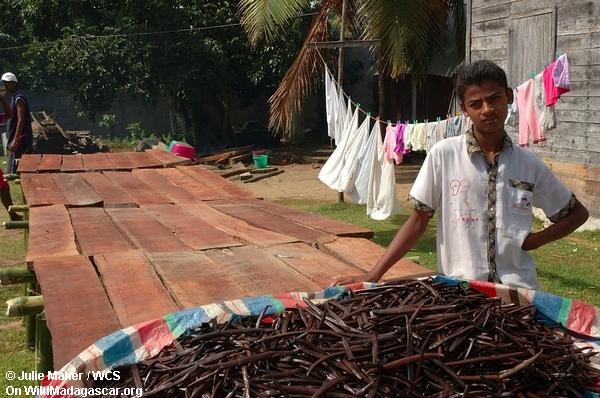Madagascar hit by deadly vanilla-killing fungus
mongabay.com
December 8, 2008
|
|
Madagascar, the world’s largest producer and exporter of vanilla, has been hit by a deadly, incurable fungus that can kill vanilla plants before their pods reach maturity, reports The Associated Press. The development could have dire impacts for the country’s vanilla industry which generates hundreds of millions of dollars per year for the impoverished Indian Ocean island nation.
“The situation is critical,” Simeon Rakotomamonjy, A Malagasy government scientist and an author of a new assessment on the crop disease, told The Associated Press. “The disease now affects 80 percent of plantations around Sambava and Andapa,” major producing areas in the northeastern part of the island. Madagascar accounts for nearly 60 percent of global vanilla production, according to figures from the U.N. Food and Agriculture Organization. In 2006 the worldwide vanilla trade was worth $422 million.
 Vanilla bean production process. Vanilla prices peaked at $500 per kilogram in 2003 but plunged to less than $30 last year Photo by Julie Larsen Maher of the Wildlife Conservation Society (WCS) |
The researchers say a spike in vanilla prices ten years ago encouraged poor planting practices — including placing plants too close together — which have contributed to the spread of the fungus between plants. Vanilla prices tend to follow a boom-and-bust cycle, closely linked crop production in Madagascar. Cyclones — which periodically affect the vanilla-producing region of Madagascar — and other disruptions drive prices higher.
Alain Paul Andrianaivo, a plant specialist, told the AP that fungal spores “attack a vanilla plant at the root, and a black rot spreads upward, often killing pods before they reach maturity.” The disease is known only by its local name, bekorontsana, which means “falls to the ground often.”
The researchers say that replanting affected areas with a fungus-resistant variety of vanilla could help the situation. However due to the long lifecycle of vanilla— it takes at least five years before a vanilla orchid will produce beans harvested for extract — relief will be far from immediate for growers.
Traditionally, vanilla is grown in the shade of large trees found in the warm, humid forests of northeastern Madagascar. Vanilla plantations are meticulously managed by growers who often cultivate other crops including cloves, pepper, and rice on adjacent lands. So valuable are vanilla beans that some growers brand each bean with their mark to denote ownership.
Vanilla is a widely used flavoring in Europe and the United States. Best known for its use in ice cream, vanilla is also used in many deserts and beverages.